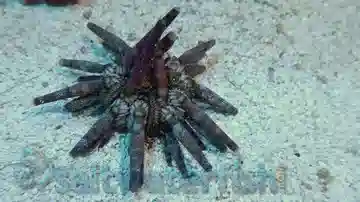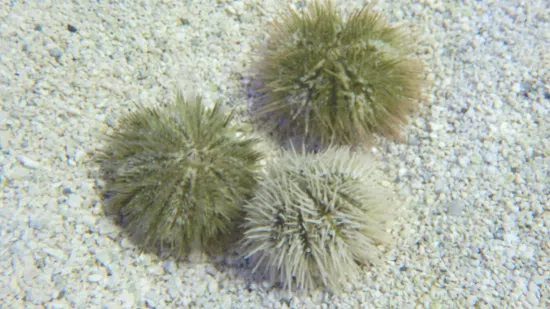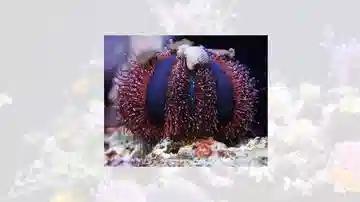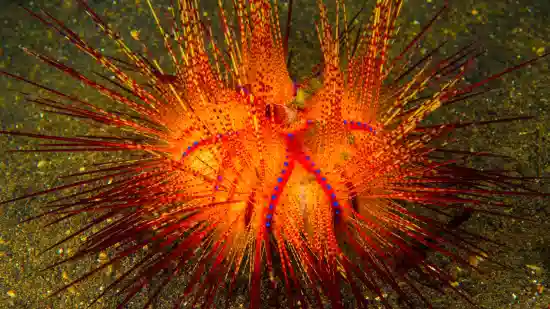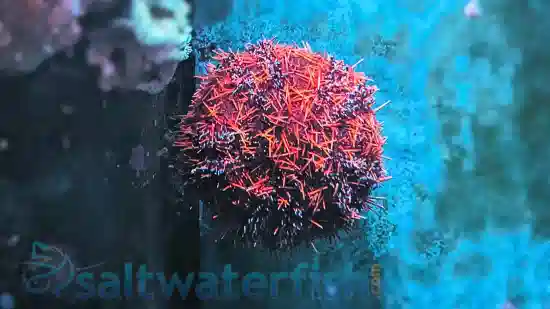Urchins In Saltwater Aquariums: FAQ
Caring for urchins in a saltwater aquarium is simple once you understand their needs. These fascinating invertebrates are peaceful, reef-safe algae grazers that thrive in stable, mature tanks with plenty of live rock to explore. They help maintain a clean, balanced ecosystem, but because they’re sensitive to water quality and metals, consistency and gentle handling are key to long-term success.
Core care requirements for saltwater urchins:
Stable water parameters
Keep salinity between 1.024–1.026, pH at 8.1–8.4, and temperature between 75–78°F.
Maintain calcium (400–450 ppm) and alkalinity (8–12 dKH) to support healthy spine and shell growth.
Avoid all copper-based medications or metal contamination, urchins are extremely sensitive to trace toxins.
Adequate food supply
Provide natural algae growth on live rock or supplement with nori sheets or algae wafers if your tank is spotless.
Ideal diet includes film, hair, and coralline algae, urchins are constant grazers that help control buildup naturally.
Safe and stable environment
Secure all rockwork and coral frags; urchins are strong movers that may accidentally shift loose pieces.
Moderate lighting and gentle water flow help them stay active without exhaustion.
Avoid housing with large predatory fish (triggers, puffers, or wrasses that nip at invertebrates).
Acclimation and introduction
Use a drip acclimation method over 45–60 minutes to prevent osmotic shock.
Introduce slowly and keep lights dim for a few hours to reduce stress.
One Saltwaterfish.com reviewer of the Red Tuxedo Urchin shared: “These are the best urchins for any aquarium from a nano to 500+ gallons. They stay pretty small, and don’t knock over your frags like many others do. They’re the most beautiful urchins in my opinion, and are RAVENOUS algae eaters.”
Pro care tips:
Test water weekly to catch early parameter shifts.
Provide shaded areas and rock crevices for resting.
Perform 10–15% water changes regularly to replenish minerals.
Supplement trace elements in heavily stocked reef tanks.
Bottom line:
Caring for urchins comes down to stability, nutrition, and clean water. With consistent parameters, adequate algae, and gentle acclimation, these reef-safe grazers can thrive for years while keeping your live rock pristine. For hardy, captive-conditioned urchins perfect for any reef setup, explore Saltwaterfish.com’s urchin collection, all backed by our 8-Day Live Guarantee for healthy, active arrivals.
The size of a sea urchin in a reef aquarium depends on its species, diet, and available space, but most commonly kept reef-safe urchins reach 2 to 4 inches in diameter (not including spines) when fully grown. Some larger species can exceed 6 inches across, while smaller varieties stay compact, making them suitable for nano or mid-sized reef tanks. Growth rates are moderate, but consistent: healthy urchins fed a balanced diet and kept in stable water conditions will reach adult size within one to two years.
Average adult sizes of popular reef-safe urchins:
Tuxedo Urchin (Mespilia globulus): \~3 inches body diameter; spines extend to about 4 inches total. Compact and ideal for mixed reefs.
*Pincushion Urchin (Lytechinus variegatus): 3–4 inches; known for its round shape and strong grazing power.
*Blue Tuxedo Urchin (Mespilia sp.): 2–3 inches; small, colorful, and gentle on coral structures.
*Longspine Urchin (Diadema setosum): Can reach up to 6 inches in body diameter with spines exceeding 10–12 inches, best for large tanks (100+ gallons).
Factors that affect urchin size and growth:
Diet: A steady supply of film, hair, and coralline algae, or supplemental nori and spirulina wafers, supports healthy, proportional growth.
Water parameters: Consistent calcium (400–450 ppm) and alkalinity (8–12 dKH) are vital for spine and shell development.
Tank size: Smaller systems may naturally limit growth, while larger tanks encourage fuller development.
Species genetics: Some urchins are naturally dwarf species designed for compact reef spaces.
Andrew, N.L. (1989) showed that habitat complexity and food density determine urchin growth potential and survival in reef systems.
One Saltwaterfish.com reviewer of the Black Longspine Urchin shared: “Very unique specimen to have in the tank.”
Pro reef tips for healthy growth:
Provide enough rockwork and algae to graze, or supplement with dried seaweed.
Maintain trace minerals through regular water changes.
Avoid overcrowding: urchins need space to roam and clean efficiently.
- Choose species suited to your tank size; small tanks should avoid large-spined varieties.
Bottom line:
In reef aquariums, most urchins grow to 2–4 inches across, with larger species reaching up to 6 inches or more in spacious systems. Their slow, steady growth makes them excellent long-term additions to reef tanks, both decorative and functional. For healthy, reef-safe urchins that stay appropriately sized for your aquarium, explore Saltwaterfish.com’s urchin collection, all backed by our 8-Day Live Guarantee for healthy, thriving arrivals.
Saltwater urchins are herbivorous grazers that play a vital role in keeping your aquarium clean and balanced. They spend nearly all their time feeding on various types of algae and organic film, using a unique five-toothed mouth called Aristotle’s lantern to scrape rock, glass, and substrate surfaces. Because they’re such efficient eaters, understanding their diet helps you keep them well-fed, especially in spotless, established reef tanks where natural algae may run low.
Primary foods in an aquarium diet:
Microalgae and film algae: The foundation of their diet; urchins constantly graze on thin films that grow on live rock and glass.
Hair algae and turf algae: Many species, including the Tuxedo Urchin (Mespilia globulus) and Pincushion Urchin (Lytechinus variegatus), consume nuisance algae, helping keep the reef clean.
Coralline algae: While urchins may scrape some coralline algae, they typically only remove surface layers while grazing.
Detritus and biofilm: Organic debris and bacterial film also serve as supplemental nutrition.
Supplemental feeding (when algae is scarce):
Offer dried seaweed (nori) sheets clipped to rockwork or held in place with a rubber band.
Provide algae wafers or sinking spirulina pellets a few times a week.
Rotate foods to maintain balanced nutrition and avoid starvation in ultra-clean tanks.
Ogden et al. (1973) measured herbivorous urchins consuming up to 40% of surface algae per day, a rate that naturally prevents algal overgrowth (Science, 182:715–717).
One Saltwaterfish.com reviewer of the Blue Tuxedo Sea Urchin shared: “Arrived as described and doing great in its new home.”
Pro feeding tips:
Ensure calcium and magnesium levels remain stable (Ca 400–450 ppm; Mg 1250–1350 ppm) to support spine health during constant grazing.
Avoid overfeeding fish in the same tank, urchins prefer clean rockwork and light natural algae growth.
Place supplemental foods near rock crevices to make them easier for urchins to find.
- Monitor behavior: a constantly roaming urchin that stops eating may signal nutrient imbalance or lack of available algae.
Bottom line:
Saltwater urchins are natural algae grazers that thrive on film, hair, and coralline algae, but they also benefit from supplemental feeding with nori or algae wafers in clean reef tanks. Keeping them well-fed not only prevents starvation but enhances their effectiveness as one of the ocean’s best clean-up crew members. For healthy, reef-safe urchins like the Tuxedo and Pincushion Urchin, explore Saltwaterfish.com’s urchin collection, all backed by our 8-Day Live Guarantee for confident, algae-free reefkeeping.
Sea urchins are hardy yet highly sensitive invertebrates, and when something is off in your aquarium, they’re often among the first to show it. Recognizing early signs of stress can help you correct water parameters or environmental issues before they become fatal. Healthy urchins are active, firmly attached, and constantly grazing, while stressed ones quickly become sluggish, pale, or lose spines.
Common signs of stress in urchins:
Spine loss: One of the clearest warnings. Spines may drop due to sudden salinity or temperature changes, copper exposure, or poor water quality.
Weak grip: Stressed urchins lose suction in their tube feet and may detach or roll around the tank.
Reduced movement: A normally active grazer that becomes still or hides for long periods is likely reacting to stress or chemical imbalance.
Color fading or patchiness: Dull or bleached spines indicate stress, malnutrition, or elevated nitrate levels.
Floating or drifting: Often caused by oxygen deprivation, pH swings, or osmotic imbalance.
Spines drooping or clumped: A sign of early stress before actual spine loss begins.
Most common causes of urchin stress:
Salinity or temperature swings: Even slight changes can shock their internal chemistry.
Copper or metal exposure: Extremely toxic to echinoderms, even at trace levels.
Low calcium or alkalinity: Causes brittle shells and weak spines.
Ammonia or nitrite spikes: Lethal at even minimal concentrations.
Starvation: Tanks that are “too clean” may lack algae; supplement with nori or algae wafers.
One Saltwaterfish.com reviewer of the Pencil Urchin shared: “Arrived healthy and active\! These guys are a great addition to any tank, fun to watch. They move more than I expected.”
Pro recovery tips:
Check water immediately: salinity (1.024–1.026), calcium (400–450 ppm), alkalinity (8–12 dKH), and temperature (75–78°F).
Perform small, gradual water changes instead of large, sudden ones.
Run activated carbon to remove any toxins or heavy metals.
- Supplement feeding with seaweed or algae wafers if your tank is spotless.
Bottom line:
Stress in urchins usually appears as spine loss, inactivity, or detachment, and almost always stems from unstable or contaminated water. Act quickly, correcting parameters early can prevent irreversible damage. For hardy, reef-safe species that adapt smoothly to home aquariums, shop Saltwaterfish.com’s urchin collection, all backed by our 8-Day Live Guarantee for confident, healthy reefkeeping.
Sea urchins are hardy invertebrates when kept under stable, reef-quality water conditions, but they’re also among the most sensitive to sudden parameter swings or contaminants like copper. Maintaining the right balance of salinity, temperature, and alkalinity ensures healthy growth, strong spines, and active grazing behavior.
Ideal water parameters for urchins:
Temperature: 75–78°F (24–26°C) Consistent temperature supports metabolic stability and prevents stress.
Salinity: 1.024–1.026 specific gravity. Avoid rapid salinity changes; fluctuations can cause spine loss or detachment.
pH: 8.1–8.4 Stable pH helps maintain calcium absorption for healthy shell and spine growth.
Alkalinity: 8–12 dKH Supports proper skeletal structure and buffer capacity.
Calcium: 400–450 ppm Essential for building and maintaining the urchin’s test (shell) and spines.
Magnesium: 1250–1350 ppm Balances calcium levels and prevents precipitation.
Ammonia and Nitrite: 0 ppm Even trace amounts can be lethal to urchins.
Nitrate: \<10 ppm Low nitrate helps preserve coloration and prevent stress.
Copper: 0.00 ppm Absolutely no copper or heavy metals; urchins absorb toxins directly through their body walls.
Why stability matters:
Urchins regulate their internal chemistry through osmotic balance. Rapid changes in salinity or pH can cause water to move in or out of their cells too quickly, leading to stress, disorientation, or loss of spines. A steady environment mimicking reef-like consistency is key to long-term success.
Stumpp, M., Wren, J., Melzner, F., Thorndyke, M.C., & Dupont, S.T. (2011) showed that pH fluctuations below 8.0 severely disrupt calcification and gene regulation in echinoderm larvae.
One Saltwaterfish.com reviewer of the Purple Hairy Pincushion Urchin shared: “They’re doing their job very well”
Pro maintenance tips:
Test calcium, alkalinity, and magnesium weekly, especially in mixed reef tanks.
Perform 10–15% water changes regularly to replenish trace minerals.
Avoid dosing chemicals too rapidly; slow, measured adjustments are safest.
- Keep activated carbon in your filtration system to absorb any contaminants.
Bottom line:
Urchins thrive under stable, reef-grade water conditions, moderate temperature, high calcium, and zero toxins. Consistency is everything: sudden shifts in salinity or chemistry can stress even the hardiest species. Maintain clean, balanced water and your urchins will stay active and colorful for years. For healthy, reef-safe urchins that adapt easily to stable systems, explore Saltwaterfish.com’s urchin collection, each backed by our 8-Day Live Guarantee for confident, reef-safe success.
A healthy urchin is active, responsive, and constantly grazing across your live rock or glass. While they move slowly, their subtle signs of activity (spine movement, feeding, and firm attachment) reveal a lot about their well-being. Because urchins are sensitive to water quality and trace metals, regular observation is key to catching early stress before it becomes a problem.
Signs of a healthy urchin:
Active movement: Slowly crawls across rock or glass using its tube feet and spines. Movement may be subtle but consistent throughout the day.
Responsive spines: Spines react immediately when you approach or change lighting; they should stand upright and wave gently.
Strong attachment: A healthy urchin grips tightly to surfaces with its tube feet and can resist light water flow.
Good appetite: Constant grazing or carrying small shells and debris for camouflage (common in Tuxedo or Pincushion Urchins).
Full coloration: Even, rich color across the body and spines without dull patches or bleaching.
Early warning signs of stress or poor health:
Drooping, broken, or falling spines.
Lack of movement for more than 24 hours.
Detachment from surfaces or floating around the tank.
Faded or pale coloration.
Loss of grip, especially near high flow or poor water areas.
Common causes of urchin stress:
Rapid salinity or temperature changes.
Copper, formalin, or other medications in the water.
Starvation (tanks too clean, no algae or supplemental food).
Poor calcium or alkalinity balance leading to weakened shells.
One Saltwaterfish.com reviewer of the White Ring Short Spine Urchin shared: “Perfect health with no issues as always from Saltwaterfish.com Would recommend to anyone and everyone.”
Pro health tips:
Keep salinity at 1.024–1.026 and temperature between 75–78°F.
Maintain calcium at 400–450 ppm and alkalinity around 8–12 dKH.
Offer algae wafers or dried seaweed if your tank is spotless.
Never handle urchins roughly, spines are delicate and can break easily.
Bottom line:
A healthy urchin is active, firmly attached, colorful, and constantly grazing. If you notice spine loss or inactivity, check water quality immediately and remove any copper-based media. With stable conditions and proper nutrition, urchins live for years and provide exceptional algae control. For hardy, reef-safe species like the Tuxedo Urchin and Pincushion Urchin, explore Saltwaterfish.com’s urchin collection, all backed by our 8-Day Live Guarantee for healthy, thriving arrivals.
Yes, urchins are among the most effective natural cleaners for live rock in saltwater aquariums. They’re tireless grazers that spend nearly all their waking hours scraping algae, film, and detritus from rock surfaces. This makes them an essential part of a reef tank’s clean-up crew, helping maintain both aesthetic beauty and biological balance in your live rock system.
How urchins keep live rock clean:
Constant grazing: Urchins use a specialized mouth structure called Aristotle’s lantern, a set of five scraping teeth, to remove algae and biofilm from every crevice of live rock.
Algae control: They consume hair algae, film algae, and coralline buildup that can smother rock surfaces.
Oxygenation boost: By clearing algae layers, they increase water flow and oxygen exchange around rock pores, supporting beneficial bacteria and coral health.
Nutrient balance: Less algae means lower nitrate and phosphate levels, helping prevent blooms that can cloud the tank or compete with corals.
Best urchins for live rock cleaning:
Tuxedo Urchin (Mespilia globulus): Compact, colorful, and one of the best all-around grazers for reef tanks.
*Pincushion Urchin (Lytechinus variegatus): Excellent for larger tanks with heavy algae growth.
*Blue Tuxedo Urchin (Mespilia sp.): A hardy, reef-safe option that works well in mixed coral systems.
Sammarco (1982) demonstrated that herbivorous urchins significantly reduced algal cover and promoted coral settlement in manipulated reef systems (J. Exp. Mar. Biol. Ecol., 61:31–55).
One Saltwaterfish.com reviewer of the Red Tuxedo Urchin shared: “Alive and thriving this little guy is all over the rocks eating everything in sight. He looked a little rough at first because of the delivery issues but I couldn’t be more pleased.”
Pro maintenance tips:
Ensure calcium and alkalinity levels are stable to support healthy spines and shell growth.
Secure loose rock and coral frags, urchins are strong movers and may shift lightweight decor.
Provide occasional seaweed or algae wafers if your tank becomes spotless to prevent starvation.
- Keep salinity stable (1.024–1.026) and avoid copper-based treatments, urchins are highly sensitive.
Bottom line:
Yes, urchins are exceptional live rock cleaners, using their natural grazing behavior to prevent algae buildup, maintain nutrient balance, and keep your reef tank vibrant. For reliable, reef-safe algae control, explore Saltwaterfish.com’s collection of urchins, each backed by our 8-Day Live Guarantee for healthy, active arrivals ready to work from day one.
In general, urchins are peaceful, reef-safe invertebrates that won’t harm fish or corals directly. They are herbivorous grazers, not predators, and spend most of their time scraping algae from rocks and glass. However, their strength, size, and constant movement can occasionally cause accidental damage or disruption, especially in small or heavily aquascaped tanks. Understanding their behavior helps you prevent issues while enjoying their incredible cleaning abilities.
How urchins interact with fish:
Safe companions: Urchins don’t attack fish or compete for food. In fact, many reef fish (like gobies or blennies) coexist peacefully with them.
Accidental spines: Fish may bump into urchins when startled, especially with long-spined species like Diadema setosum. While not venomous to most fish, the spines can cause minor irritation or stress if contact occurs frequently.
Hidden benefits: By eating algae and detritus, urchins improve overall water quality, indirectly benefiting your fish’s health and gill function.
How urchins interact with corals:
They don’t eat corals: Reef-safe urchins (like the Tuxedo Urchin (Mespilia globulus)) feed only on algae and biofilm, not live coral tissue.
Potential movement issues: Their strong tube feet can knock over unsecured coral frags or loose rockwork while grazing.
Best prevention: Secure coral frags firmly with reef-safe glue or epoxy, and ensure aquascaping is stable before introducing large urchins.
One Saltwaterfish.com reviewer of the Black Longspine Urchin shared: “A unique addition to the tank, that requires zero attention. This adds a another visual element to the tank, as he roams around the tank, not bothering anyone/anything. Adds life to the rocks, and cleans the tank too. No reason to not have this in your tank, worth it\!”
Pro reefkeeping tips:
Choose compact species (like Tuxedo or Pincushion urchins) for smaller tanks.
Avoid rock-boring urchins that can scrape deep into coral bases.
Maintain calcium and alkalinity for healthy spine and shell growth.
Keep spiny species away from tight coral clusters where movement could dislodge frags.
Bottom line:
Urchins are reef-safe, peaceful, and invaluable algae grazers that pose little to no threat to fish or corals when chosen and managed properly. Their occasional clumsiness is easily offset by their cleaning benefits and natural beauty. For hardy, reef-safe species like the Tuxedo Urchin and Pincushion Urchin, shop Saltwaterfish.com’s urchin collection, each backed by our 8-Day Live Guarantee for confident, coral-safe reefkeeping.
Sea urchins are sensitive invertebrates that require a slow, gentle acclimation process to adjust safely to new water chemistry. Rapid changes in temperature, salinity, or pH can shock their system, leading to spine loss or even death. A careful acclimation routine gives your urchin the best chance to settle quickly and begin cleaning algae within hours of introduction.
Step-by-step acclimation guide:
Float the bag (15–20 minutes):
Keep the sealed shipping bag in your tank to equalize temperature. Avoid direct light and strong flow during this time.
Transfer to a clean container: Empty the urchin and bag water into a small bucket or specimen container. Never add shipping water directly into your tank, it can contain waste or low oxygen levels.
Start drip acclimation (45–60 minutes):
Use airline tubing to slowly drip tank water into the container (2–4 drops per second).
Continue until the volume doubles, matching tank salinity and chemistry.
This step is crucial, urchins are highly sensitive to even slight salinity changes.
Check salinity and temperature:
Ensure the acclimation water matches your display tank (salinity 1.024–1.026, temperature 75–78°F).
Gently transfer the urchin:
Use your hand or a soft cup to place it into the aquarium, avoid exposing it to air for more than a few seconds. Place it on a rock or glass surface away from strong currents.
Lights off for a few hours:
Dimming lights helps reduce stress and allows the urchin to attach and begin exploring safely.
One Saltwaterfish.com reviewer of the Blue Tuxedo Sea Urchin shared: “One of my favorite members of the cleanup crew. bought this one to add to one which has been in my tank for a year.”
Pro acclimation tips:
Always test salinity before starting; even small mismatches can cause stress.
Avoid nets: urchin spines can snag or break easily.
If you notice loose spines during shipping, don’t panic; gentle acclimation often allows recovery.
- Keep copper and other metals at 0.00 ppm: urchins are extremely sensitive to trace toxins.
Bottom line:
To successfully acclimate urchins, use a drip acclimation method over 45–60 minutes, ensuring temperature and salinity match perfectly before transfer. Gentle handling and patience are key, rush the process, and you risk shocking this delicate but highly beneficial reef cleaner. For healthy, acclimated urchins ready to thrive, shop Saltwaterfish.com’s urchin collection, each backed by our 8-Day Live Guarantee for confident reefkeeping from day one.
Yes, sea urchins are extremely sensitive to copper and most aquarium medications. Even low concentrations of copper, formalin, or other chemical treatments that are harmless to fish can be toxic or fatal to echinoderms like urchins, starfish, and sea cucumbers. Because of their unique biology and porous exoskeletons, urchins absorb trace metals and compounds directly from the water, which quickly affects their internal chemistry and nervous system.
Why urchins react poorly to copper:
Copper toxicity: Copper ions disrupt calcium absorption, damaging the urchin’s spines and test (shell).
Neurological sensitivity: Copper interferes with the electrical signals urchins use for movement and feeding, often leading to paralysis or death.
Bioaccumulation: Even after short exposure, copper can build up in tissues and continue harming the animal long after it’s removed from the tank.
Other medications to avoid:
Formalin- or malachite green–based treatments.
Antibiotics containing heavy metals.
Reef “quick fixes” for algae or parasites that list copper sulfate or similar ingredients.
Reichelt-Brushett, A.J., & Harrison, P.L. (2005) found that copper at concentrations as low as 0.03 mg/L disrupted gamete viability and calcium regulation in marine invertebrates, including echinoderms.
One Saltwaterfish.com reviewer of the Pencil Urchin shared: “Moves a lot and fun to watch.”
Pro safety tips:
Never use copper or medications in a tank containing invertebrates, urchins, or live rock.
Quarantine sick fish in a separate hospital tank before medicating.
Use activated carbon or Poly-Filter after any treatment to remove residual chemicals before adding invertebrates back.
Regularly test for trace metals with a copper test kit to ensure safe levels (should read 0.00 ppm).
Bottom line:
Yes, sea urchins are highly sensitive to copper and nearly all fish medications. Even trace exposure can cause irreversible harm. To keep your reef ecosystem healthy, treat fish separately and maintain medication-free water for invertebrates. For healthy, acclimated, reef-safe urchins, explore Saltwaterfish.com’s urchin collection, each backed by our 8-Day Live Guarantee for confident, stress-free reefkeeping.
Yes, most sea urchins are reef safe and make excellent additions to marine aquariums. They’re best known as natural algae grazers, keeping live rock and glass surfaces clean without harming corals or fish. However, while urchins don’t typically eat living coral tissue, some species can unintentionally cause issues by knocking over unsecured rockwork or corals as they forage. Choosing the right type of urchin for your tank size and setup is key to success.
Reef-safe urchin species:
Tuxedo Urchin (Mespilia globulus): Compact, colorful, and one of the most popular reef-safe species. Great for small to mid-sized reef tanks.
*Pincushion Urchin (Lytechinus variegatus): Excellent algae eater with a calm temperament, just give it room to graze.
*Longspine Urchin (Diadema setosum): Very effective at controlling algae in large tanks but requires care due to sharp spines.
*Blue Tuxedo Urchin (Mespilia sp.): A striking, hardy species ideal for peaceful reefs.
Urchins to avoid in reefs:
Rock-boring urchins or collector urchins may scrape live rock too aggressively or move loose coral frags.
Why aquarists love reef-safe urchins:
Natural algae control: Constant grazers that help manage diatoms and green film algae.
Low maintenance: Require little supplemental feeding if the tank has natural algae growth.
Peaceful tank behavior: Don’t bother corals, fish, or invertebrates.
One Saltwaterfish.com reviewer of the Pincushion Urchin shared: “Absolutely in love with this guy. He is so unique. And his purple color looks great in my aquarium.”
Pro reef tips:
Secure coral frags and loose rock to prevent accidental shifting.
Keep calcium levels stable (400–450 ppm) to support healthy spine and shell growth.
Supplement with small amounts of seaweed or algae wafers if your tank is spotless.
- Avoid copper-based medications, urchins are highly sensitive to metals.
Bottom line:
Most sea urchins are reef safe, peaceful, and essential for natural algae control. Just choose the right species for your aquarium size and rockwork stability. For healthy, aquacultured urchins that arrive acclimated and ready to clean, explore Saltwaterfish.com’s urchin collection, all backed by our 8-Day Live Guarantee for confident reefkeeping.
The best urchins for saltwater aquariums are reef-safe species that effectively control algae, adapt easily to captive conditions, and remain peaceful with corals and fish. While all urchins serve as excellent members of a tank’s clean-up crew, some are better suited to specific aquarium sizes and reef setups. The key is choosing species that balance cleaning efficiency with manageable size and temperament.
Top urchins for home aquariums:
1. *Tuxedo Urchin (Mespilia globulus)
Best overall reef-safe urchin
Compact, colorful, and constantly grazing. Excellent for small to medium reef tanks (30+ gallons).
Feeds on film, hair, and coralline algae without disturbing corals.
2. *Pincushion Urchin (Lytechinus variegatus)
Best for larger tanks with heavy algae
Round body, short spines, and voracious appetite. Ideal for open aquascapes where it can roam freely.
3. Blue Tuxedo Urchin (Mespilia sp.)
Great for mixed reefs
Similar to the Tuxedo but with striking blue bands and calm behavior. Works well in coral-rich environments.
4. Longspine Urchin (Diadema setosum)
Best for advanced hobbyists with large tanks (100+ gallons)
Powerful algae grazer with dramatic appearance. Requires ample space and care when handling due to long, sharp spines.
Why these species stand out:
Reef-safe: None of these urchins consume coral tissue or harm fish.
Natural algae control: Constant grazers that prevent hair algae and film buildup.
Hardy and adaptable: Adjust well to stable aquarium conditions when properly acclimated.
Visually appealing: Their symmetry and color add a natural aesthetic to the reef.
One Saltwaterfish.com reviewer of the Black Longspine Urchin shared: “The perfect sized urchin and they were very healthy.”
Pro selection tips:
Choose smaller urchins for tanks under 50 gallons.
Ensure calcium (400–450 ppm) and alkalinity (8–12 dKH) levels are stable for spine health.
Avoid copper-based medications, urchins are extremely sensitive.
- Introduce slowly using the drip acclimation method to prevent stress.
Bottom line:
The best urchins for aquariums are Tuxedo, Pincushion, and Blue Tuxedo Urchins, hardy, reef-safe, and exceptional algae grazers that fit a range of tank sizes. Their balance of beauty and function makes them one of the most beneficial invertebrates in the hobby. Explore Saltwaterfish.com’s urchin collection for healthy, acclimated specimens backed by our 8-Day Live Guarantee, your reef’s clean-up crew, delivered with confidence.
Sea urchins are long-lived, resilient invertebrates that can thrive for 5 to 10 years in a well-maintained saltwater aquarium and sometimes even longer. Their lifespan depends heavily on water stability, diet, calcium levels, and the overall health of the reef system. When cared for properly, these slow-moving grazers can become lasting fixtures in your clean-up crew, maintaining live rock and preventing algae buildup for years.
Average lifespans by common aquarium species:
Tuxedo Urchin (Mespilia globulus): 4–6 years average, up to 8 years with excellent care.
*Pincushion Urchin (Lytechinus variegatus): 5–7 years, hardy and adaptable to most reef setups.
*Blue Tuxedo Urchin (Mespilia sp.): 4–6 years, thrives in stable, algae-rich environments.
*Longspine Urchin (Diadema setosum): 7–10 years or more in large, established tanks.
Factors that influence lifespan:
Stable water parameters: Urchins are sensitive to rapid changes in salinity, temperature, or pH. Keep salinity at 1.024–1.026 and temperature around 75–78°F.
Calcium and alkalinity balance: Maintain Ca 400–450 ppm and Alk 8–12 dKH for strong spine and shell growth.
Adequate nutrition: Provide consistent algae availability or supplement with nori, spirulina, or algae wafers in spotless tanks.
Toxin-free water: Avoid copper, formalin, or heavy metal exposure, all are lethal to echinoderms.
Gentle handling: Physical injury or rough netting can shorten lifespan dramatically.
One Saltwaterfish.com reviewer of the Blue Tuxedo Sea Urchin shared: “A fantastic addition to my 6 gallon nano. A beautiful urchin and a disaster for the hair algae in my tank.”
Pro longevity tips:
Perform small, regular water changes to maintain mineral balance.
Feed sparingly but consistently if natural algae is low.
Keep lighting moderate to support controlled algae growth for natural grazing.
Monitor for spine loss or inactivity, early indicators of stress or parameter imbalance.
Bottom line:
With proper care and a stable reef environment, most aquarium urchins live 5 to 10 years, making them one of the longest-living, most reliable members of your clean-up crew. Their slow, steady grazing helps maintain a balanced ecosystem year after year. For healthy, reef-safe species like the Tuxedo Urchin and Pincushion Urchin, shop Saltwaterfish.com’s urchin collection, all backed by our 8-Day Live Guarantee for confident, long-term reefkeeping.
Yes, urchins can reproduce in captivity, though successful breeding and larval rearing are rare in home aquariums. Most commonly, urchins reproduce by broadcast spawning, where males and females release eggs and sperm into the water column simultaneously. In large, stable reef systems, this can happen naturally under the right conditions, but the delicate larvae that result are planktonic and extremely difficult to raise without specialized filtration and feeding setups.
How urchin reproduction works:
Spawning triggers: Temperature changes, moonlight cycles, and seasonal shifts often trigger spawning behavior. In aquariums, it may occur spontaneously during water changes or lighting changes.
Visual cues: During spawning, urchins climb to elevated rock surfaces and release thin, milky clouds of gametes into the water. This process can temporarily cloud the tank for several minutes.
Fertilization and larval stage: Fertilization happens externally in the water. The resulting larvae, called pluteus larvae, float for several weeks feeding on microalgae before settling and transforming into juvenile urchins, a stage that’s nearly impossible to replicate in typical reef tanks.
Challenges of breeding in home aquariums:
Filtration sensitivity: Protein skimmers and mechanical filters quickly remove gametes and larvae.
Larval diet: Requires constant access to live phytoplankton, which most home systems can’t support.
Survivability: Even in laboratory studies, survival rates beyond two weeks are very low without specialized planktonic nurseries.
One Saltwaterfish.com reviewer of the Red Tuxedo Urchin shared: “My red tuxedo urgent is doing his job and looks awesome in my tank.”
Pro tips if spawning occurs:
Perform a partial water change afterward to remove excess gametes.
Turn off protein skimmers briefly during spawning to avoid overflow.
Monitor ammonia and oxygen levels closely, spawning can temporarily impact water quality.
Don’t expect viable offspring; focus on stabilizing the tank environment.
Bottom line:
Yes, urchins do reproduce in captivity, but raising baby urchins is extremely difficult outside controlled breeding systems. Spawning events are harmless and even fascinating to witness, they’re signs of a healthy, mature reef environment. For hardy, well-acclimated urchins likely to thrive and possibly spawn in your setup, explore Saltwaterfish.com’s urchin collection, all backed by our 8-Day Live Guarantee for confident, reef-safe success.



